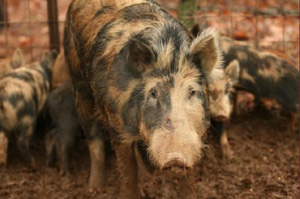Feral Hog Control Workshop in Texarkana
TEXARKANA, Ark. –
Feral Hog Control Workshop in Texarkana
Thursday, December 8, 2016, 3:30 pm – 5:00 pm
Location – Southwest Electric Cooperative (REA)
Texarkana, Arkansas
Register to attend this FREE event by calling 870-779-3609 or email jcaraway@uada.edu by December 5.
The Miller County Extension Service is offering a free Feral Hog Control Workshop on December 8, 2016, from 3:30-5:00 p.m. at the Southwest Electric Cooperative building (REA). Please pre-register for this event by calling 870-779-3609 or email jcaraway@uada.edu by December 5, 2016.
Feral hogs are domesticated swine released accidentally or purposefully for sport hunting. After a generation or two, progeny of a domesticated hog appear untamed, with thickened fur and tusks. Sows produce litters (average six piglets) starting at six months of age and have few predators after reaching maturity.
Their feeding and wallowing behaviors create a number of problems, including agriculture crop loss, pasture damage, wildlife habitat loss, water pollution (e.g., sedimentation, transmission of E. coli), and disease transmission to livestock and in rare cases, people. Non-native feral hogs compete directly with native wildlife species for limited food supplies, disturb habitat, and consume small mammals and reptiles, the young of larger mammals (e.g., fawns), and eggs and young of ground-nesting birds (e.g., bobwhites, wild turkey).
Although small herds of feral hogs have lived in Arkansas for generations, the feral hog population in the state has increased and expanded dramatically in recent years. Many believe this expansion into previously uninhabited areas is from hog releases by sport hunters. The National Feral Swine Mapping System is updated monthly using data collected from state wildlife agencies and USDA APHIS Wildlife Services. These maps illustrate the dramatic expansion of feral hogs throughout North America.
Controlling the prolific feral hog has proven difficult. Feral hogs are very adaptive and learn to avoid hunters and traps. Hogs are very mobile, and will range for miles in search of food or mates. Most feral hogs are nocturnal, and therefore unseen. Signs of feral hogs are rooting, tracks, wallows, nests or beds, tree and post rubs.
For more information on feral hogs and their control, visit http://uaex.uada.edu/feralhogs
By Miller County Agent
County Extension Agent - Agriculture
The Cooperative Extension Service
U of A System Division of Agriculture
Media Contact: Miller County Agent
County Extension Agent - Agriculture
U of A Division of Agriculture
Cooperative Extension Service
400 Laurel Street, Suite 215 Texarkana AR 71854
(870) 779-3609
jcaraway@uada.edu
Related Links
The Arkansas Cooperative Extension Service is an equal opportunity institution. If
you require a reasonable accommodation to participate or need materials in another
format, please contact your County Extension office (or other appropriate office)
as soon as possible. Dial 711 for Arkansas Relay.
Pursuant to 7 CFR § 15.3, the University of Arkansas System Division of Agriculture
offers all its Extension and Research programs and services (including employment)
without regard to race, color, sex, national origin, religion, age, disability, marital
or veteran status, genetic information, sexual preference, pregnancy or any other
legally protected status, and is an equal opportunity institution.
